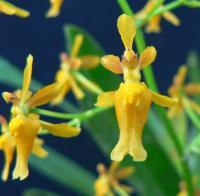An Introduction to Orchids - Part 2

No one really knows how many species of Orchids grow in the wild around the world, but estimates vary from 6,000 to 10,000, making it a family with more flowering species than any other.
Sadly a high percentage are endangered, with some now extinct. However, every year new species are being discovered and keen growers are eager to get hold of young plants as soon as professionals have germinated seed and raised them to a reasonable size. It is difficult to be certain, but some 100,000 to 200,000 hybrids may also have been produced, though most of these will never become available to the general public.
Growing Conditions
The image that commonly springs to mind when we think of orchids in the wild is that of a classical steamy jungle. Many do grow in this environment, but surprisingly the average height at which they grow is 5,000 feet, with others growing at up to 14,000 feet. Some are terrestrial (growing in the ground, as is the case for all the UK species). Others grow in tree branches (like the ubiquitous Phalaenopsis) with dry rocks also being a natural habitat for some species.
So, what is the point of knowing where they grow? Well, for the common Orchids that we buy for our homes or greenhouses, we need to try to reproduce (as far as we can) similar conditions to those experienced in the wild. Although thankfully hybridisers have worked hard to create plants that will often tolerate conditions which are less than ideal, since most plants are bought as pot plants for the home and office.
Orchids, like all other plants, will survive under less-than ideal conditions, but if their growing environment is too unlike their natural habitat, they will not thrive. Sometimes a few simple rules enable us to grow plants reasonably well even in relatively poor conditions. For example, if our temperatures are low (like a winter minimum of 10C at night in the living room when a plant really prefers 21C) then keeping the plant roots on the dry side helps to prevent root rot.
Flower Shapes
Orchids are said to be the most highly evolved of all flowering plants, with some hardly looking like flowers at all and others just looking plain weird. Here is an abbreviated list of what Orchids can often resemble:
- An Octopus
- A Human Nose
- An Onion
- Mickey Mouse
- A Monkey
- A Butterfly
- Camel Hooves
- A Drunken Old Man
- A Squirrel
- Fancy Shoes for a King
- A Vampire Bat
- A Ghost
- A White Frog
Their common names often reflect their appearance, like "ladies tresses" and "clown". Some Orchids can even appear dead, although in our own amateur collections if they look dead, they probably are! However, on the positive side, Orchids actually take a long time to die, unlike most other plants.
Size and Colour
The smallest Orchids are microscopic (exhibitors often provide a magnifying glass at shows so the public can actually see what the grower is raving about), whilst the largest flowers are the size of footballs.
Almost every colour exists, except black. Someone did produce a photo of a black one once and created quite a stir in the Orchid world, but it was later found to be fake. Blue is also not an easy colour to create, although the vandas are increasingly getting more blue through hybridisation. Some Orchid flowers are plain, some are striped and many have 'mismatched' colours.
Judges at shows know what makes a good plant and flower. Some readers will be quite competitive and will try to acquire the best "pedigrees", and thus hope to win awards, though they rarely get rich. Most of us are content to have flowers we can enjoy and the long-lasting Phalaenopsis are still very popular, as used to be the Cymbidiums, though these are making something of a come-back. They also are long lasting.
In the following articles in this series we will consider the growing conditions required for Orchids, such as temperature, light and humidity as well as reproducing Orchids, potting materials and their feeding requirements.
This article was written by Dr Derek Copley, Chairman of the Bournemouth Orchid Society.
Filed under House Plants.

